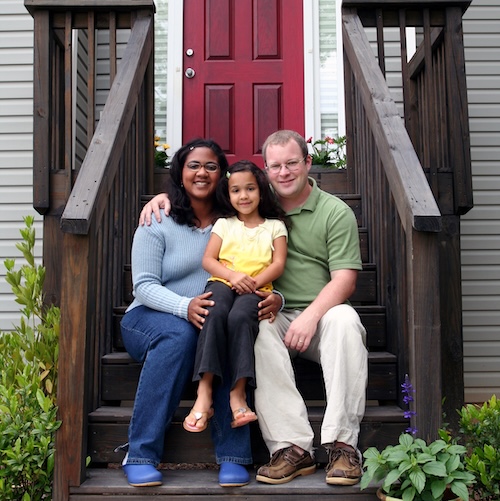Rent-to-own homes: How it works and what to consider
Contributed by Sarah Henseler
Nov 22, 2025
•8-minute read

There are many renters who would like to buy a home but don’t quite have enough saved to make a down payment. According to data from Redfin, these days, the average home costs over $400,000, which means that even just a 3% down payment on a home like that would cost at least $12,000. Another option is what’s called a rent-to-own home. With this kind of arrangement, you can rent a home with the end goal of buying it. Here’s a closer look at how rent-to-own homes work and the pros and cons of this type of path to homeownership.
What is a rent-to-own home?
A rent-to-own home is a residence that you rent for a set period with the intention to buy it down the line. Unlike in a typical rental agreement, you get the option to purchase the property before the lease expires. This gives renters time to save up for a down payment and potentially improve their credit.
Your rent-to-own agreement will spell out how long you can rent the home before you must decide whether or not you buy it. Your agreement might also require that you pay an up-front option fee to the home’s owner. This fee, which is typically 1% - 5% of the home’s value, locks in your option to buy the home and can later be used to reduce the purchase price if you decide to move forward with the purchase.
Say you pay $5,000 as an option fee and you and the owner agree on a $350,000 sales price for the home you are renting. You can apply the $5,000 option fee you’ve already paid to reduce the sales price to $345,000.
How does rent-to-own work?
When you enter into a rent-to-own arrangement, you’ll set the rental period with the owner. Rent-to-own agreements tend to be longer than standard 1-year leases and are often 2 to 3 years. You’ll also set the purchase price of the home and the up-front option fee.
Some rent-to-own agreements will specify that a certain portion of your monthly rent is saved in an escrow account. You can later use these funds, known as rent credits or rent premiums, to help cover a down payment when you buy the house. That way, with each rent payment you make, you’re saving up your down payment at the same time.
Rent-to-own agreements do come with risks, though. If you decide not to purchase the home, you’ll typically lose the money set aside in this escrow account. You’ll usually lose any option fee that you pay, too.
If your option fee is 1% - 5% of the home’s value and the property you are renting is valued at $250,000, you could lose $5,000 – $17,500 if you don’t purchase the home at the end of your lease.
Types of rent-to-own agreements
There are two main types of rent-to-own agreements, lease-option and lease-purchase.
Under both options, you can lease a home for a specified time and have the choice to buy the home as your lease ends. One option, though, comes with more flexibility.
Lease-option
Under the lease-option arrangement, you agree to rent a home for a set period. You’ll typically:
- Pay an option fee of 1% - 5% of the home’s value up front
- Pay extra in rent each month to be later used for your down payment
- Agree on a sales price which will be what you pay regardless of what happens to the value of the home in the interim
- Have the option to buy the home at the end of the lease
The important distinction with the lease-option is that you’re not required to buy the home at the end of the lease. You can walk away from the purchase. If you do, you’ll usually lose both the extra you paid each month in rent and your option fee. The lease-option is more flexible, even if you might lose some money if you don’t end up buying the home.
Lease-purchase
A lease-purchase agreement requires both the seller to sell the home and you to buy the home at the end of your lease period. This differs from a lease-option agreement that only requires the seller to offer the home for sale at the end of the leasing period.
In other ways, a lease-purchase agreement works similarly to a lease-option arrangement, with a key difference at the end:
- You and the seller will agree to a lease period
- Both you and the seller will agree to any special clauses or contingencies that allow you to walk away from the deal without penalty
- Your lease-purchase contract will state the sales price.
- You’ll pay extra in rent each month to save up a down payment
- You’ll be required to buy the home at the end of the lease period.
Another key difference with a lease-purchase agreement is you might not be required to pay an option fee. However, if you decide not to buy the home after the lease ends, you will be in violation of your contract. The homeowner could sue you for breach of contract. You’ll also lose the extra rent you’ve paid. This can also happen if you try to purchase the home but can’t because you don’t qualify for mortgage financing.
Is rent-to-own a good idea?
Whether a rent-to-own agreement is right for you will depend largely on your financial situation.
If you don’t have enough money saved to cover a down payment, a rent-to-own agreement could buy you a few years to save one up all while securing a home that you want to buy.
Rent-to-own could also be a good option if your credit score is so low that you either can’t qualify for a mortgage or can only qualify for one with a high interest rate. You’ll have time to take the steps necessary to improve your credit score while leasing the home you’ll eventually buy.
On the other hand, if you already have enough money saved for a down payment and your credit score is strong, a rent-to-own arrangement probably doesn’t make sense.
Rent-to-own homes: Pros and cons
Entering into a rent-to-own agreement on a home can come with certain perks and downsides.
Pros
Some of the advantages of rent-to-own homes include:
- You can lock in your sales price: With some rent-to-own agreements, you and the owner of the home agree on a sales price when you sign your lease agreement. If the home’s value rises throughout your lease, you might end up paying less than market value for the home.
- You can save for a down payment: Each month, you’ll pay a higher rent and the extra money gets saved as a rent credit. When it’s time, you can use this extra money to help cover the down payment on the purchase of the home.
- You have time to improve your credit: If your credit score is too low for you to qualify for a mortgage, you can rent the home while taking steps to improve your credit score. You can do this by making your monthly payments on time and paying down your credit card balances. When the lease period ends, your score might be high enough to qualify for a mortgage with a lower interest rate.
- You can save on moving costs: If you end up buying the same home that you’re renting, then you won’t have to move. This can save you a significant amount of money in moving costs.
Cons
Rent-to-own homes can also come with downsides, such as:
- You could lose money: If you don’t decide to purchase the home after your lease period ends, you could lose your option fee and the extra money you paid each month for your future down payment.
- You might overspend: In some rent-to-own agreements, you and the home’s owner decide on a purchase price at the beginning of your lease period. If the home’s value declines while you are leasing, you might end up paying more for the home than its current value when it’s time to buy.
- You will have to pay fees: You’ll often pay both a lease option fee and higher monthly rents during a rent-to-own agreement.
- You might be responsible for maintenance and upkeep of the home: When you rent an apartment, it’s your landlord’s responsibility to keep the lawn mowed and repair leaking pipes or fix broken windows. In a rent-to-own agreement, these responsibilities might fall onto you depending on the terms of your lease.
How to buy a rent-to-own home
How do you find and buy a rent-to-own home? Here are the key steps:
1. Determine your budget
Start by creating a household budget that lists your monthly expenses and income. Be sure to include expenses that vary, such as groceries, health care costs, and monthly utility bills. Also included discretionary spending, like the money you spend on entertainment and eating out.
Once you have a budget listing the money coming into and out of your household each month, you can determine how much you can afford to pay in monthly rent and upfront fees. You can also determine how much you can afford to spend on a monthly mortgage payment once you purchase the home.
2. Find a rent-to-own home
But how do you find a rent-to-own home? Your best bet is to work with a real estate agent who can help you find these properties in the neighborhoods in which you want to buy. You can also search online for rent-to-own portals that list these properties.
3. Negotiate the terms
You’ll need to negotiate everything from your monthly rent to the size of your option fee to whether you are entering into a lease-option or lease-purchase agreement. Negotiate the eventual purchase price of your home, either settling on a price that remains fixed throughout your lease period or one that might rise or fall depending on home values when you are ready to buy.
4. Review the agreement
After you and the seller agree on the terms of your deal, review the rent-to-own agreement. Look for key items such as your monthly rent, the length of the lease period, and the price of the home once you’re ready to buy. Ensure these terms are identical to the ones upon which you and the seller agreed. Consider hiring a real estate attorney who can review the agreement.
5. Pay the option fee and pay rent
If you enter into a lease-option agreement, you’ll pay your option fee up front. The amount you’ll pay varies by transaction but is typically negotiated before you sign your rent-to-own agreement. Once you sign, you’ll start paying your monthly rent as you would with any rental, except with a little extra built in to set aside for a down payment.
6. Apply for a mortgage
As your lease period is nearing its end, it’s time to apply for a mortgage to finance the purchase of the home. Your lender will check your credit reports and credit score and verify your income and debts. If you need advice about the mortgage-lending and home-buying process, check out our home buying checklist.
The bottom line: Review the terms of your agreement before renting to own
If you’re ready to buy a home, a rent-to-own arrangement could get you closer to your goal. Just make sure to read the fine print of your leasing agreement so that you’re not overpaying for your eventual home. And if your rent-to-own agreement is nearing its end? You can start the mortgage approval process with Rocket Mortgage® today.
The 3% down payment option is only available on certain conventional loan products and is not available in all states. Additional terms and conditions may apply.

Rory Arnold
Rory Arnold is a Los Angeles-based writer who has contributed to a variety of publications, including Quicken Loans, LowerMyBills, Ranker, Earth.com and JerseyDigs. He has also been quoted in The Atlantic. Rory received his Bachelor of Science in Media, Culture and Communication from New York University.
Related resources

8-minute read
How to buy a house with no money down
Some mortgages allow you to buy a house with no money down. Learn how to buy a house with n...
Read more
9-minute read
Starter home or forever home: Which is right for you?
A starter home is a small, affordable home for first-time buyers. Find out if it makes sense to buy a starter home or if a forever home is right for you.
Read more

8-minute read
How much income do I need to buy a house?
Debating if you have the funds to purchase a home? Learn how much income you’ll need to buy a house and what lenders consider when reviewing applications.
Read more